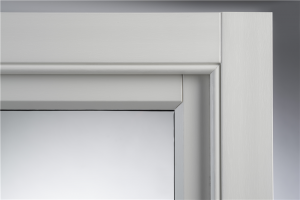Masterframe Trade
SASHES SAVE ON ENERGY
Growing in Repute
With 30 per cent of all UK generated CO2 coming from domestic housing stock emissions, the focus is on the window industry.
Every building loses heat. A ‘standard’, single glazed window loses 5.8W/sq m every hour per 1°C temperature difference, equating to a 5.8 U value. Double glazed windows typically lose 2.8W while current Building Regulations require a U value of 2.0 (or 1.8 in Scotland). But U values only calculate how much energy a window loses.
The new measurement of a window’s energy efficiency – the Window Energy Rating (WER) – looks at the total performance of a window, taking into account how much energy can be gained. The WER uses the same A to G rating system as that used on white goods and is supported by The Energy Saving Trust.
U values of 2.8 would not register on this chart, and the current building regulation window of 2.0 would only achieve an F or G rating. Windows with a high rating can save energy (and heating bills for home owners) and cut down on carbon dioxide emissions.
Masterframe was the first UK window company to receive an energy efficient C rating from The British Fenestration Ratings Council (BFRC), the regulatory body of the WER, in June this year. It was an achievement that won the company the glazing industry award for Energy Efficiency Initiative of the Year. It also means Masterframe and its Bygone preferred installers can use the Energy Saving Recommended logo.
Masterframe used a three chambered sash profile with low iron glass on the outside and hard coat, low E glass inside. An argon filled sealed unit and a warm edge spacer ensure that energy loss is minimal.
Awareness sought
WERs have opened up a whole new market for the window industry – the ‘green’ consumer. It’s a chance to overturn the poor reputation of pvcu and promote the industry. However, there are still only a handful of window companies with any kind of WER. Yet, currently, there is not much incentive for installation companies to buy and promote energy efficient windows as most home owners are not aware of the WER.
Environmental issues are not the public’s only concern. Walk round any British town and you’ll see inappropriate replacement windows – poor installation, dummy sashes and dodgy sight lines, for example – disfiguring the landscape and devaluing homes. And it’s not just pvcu to blame.
Now there are windows that can restore the houses to their original glory, recreating their character and charm without losing any energy efficiency benefits. Masterframe’s Bygone Collection window is a fully working pvcu sliding sash with traditional features such as a deep bottom rail, authentic Georgian bars, brass cam and keep catches and the option of a white, wood grain foil finish, all of which makes it virtually indistinguishable from timber.
Opening cycles
Masterframe’s Bygone Collection sliding sash windows are still the only windows to achieve British Board of Agrément ‘system status’ that tests the whole window for 20,000 opening cycles or a 20 years’ life expectancy. This is a 100 per cent increase on previous certificates which only tested balance and hardware endurance and then only to 10,000 cycles. The company has asked the BBA to publicly state that there are now two standards, so profile suppliers will be pressured to upgrade their certification.
So what’s the future? It’s not enough to rest on one’s laurels or even to continue developing more energy efficient windows and innovations. We have to work together to promote Window Energy Ratings to the public. The government needs to encourage public acceptance and use of energy efficient products by educating consumers and promoting new advances through the media and applying reductions in VAT in line with those for insulation materials.
This article was published in PSLG magazine February 2006. To view the article as it was originally printed then please click here




